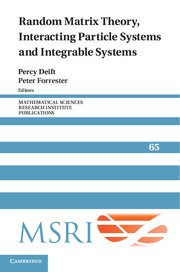Book contents
- Frontmatter
- Contents
- Preface
- Universality conjecture for all Airy, sine and Bessel kernels in the complex plane
- On a relationship between high rank cases and rank one cases of Hermitian random matrix models with external
- Riemann–Hilbert approach to the six-vertex model
- CLT for spectra of submatrices of Wigner random matrices, II: Stochastic evolution
- Critical asymptotic behavior for the Korteweg–de Vries equation and in random matrix theory
- On the asymptotics of a Toeplitz determinant with singularities
- Asymptotic analysis of the two-matrix model with a quartic potential
- Conservation laws of random matrix theory
- Asymptotics of spacing distributions 50 years later
- Applications of random matrix theory for sensor array imaging with measurement noise
- Convolution symmetries of integrable hierarchies, matrix models and τ-functions
- Universality limits via “old style” analysis
- Fluctuations and large deviations of some perturbed random matrices
- Three lectures on free probability
- Whittaker functions and relatedstochastic processes
- How long does it take to compute the eigenvalues of a random symmetric matrix?
- Exact solutions of the Kardar–Parisi–Zhang equation and weak universality for directed random polymers
- Replica analysis of the one-dimensional KPZ equation
- Asymptotic expansions for β matrix models and their applications to the universality conjecture
- KPZ scaling theory and the semidiscrete directed polymer model
- Experimental Realization Of Tracy–Widom Distributions And Beyond: Kpz Interfaces In Turbulent Liquid Crystal
- Random matrices: the four-moment theorem for Wigner ensembles
Three lectures on free probability
Published online by Cambridge University Press: 29 May 2025
- Frontmatter
- Contents
- Preface
- Universality conjecture for all Airy, sine and Bessel kernels in the complex plane
- On a relationship between high rank cases and rank one cases of Hermitian random matrix models with external
- Riemann–Hilbert approach to the six-vertex model
- CLT for spectra of submatrices of Wigner random matrices, II: Stochastic evolution
- Critical asymptotic behavior for the Korteweg–de Vries equation and in random matrix theory
- On the asymptotics of a Toeplitz determinant with singularities
- Asymptotic analysis of the two-matrix model with a quartic potential
- Conservation laws of random matrix theory
- Asymptotics of spacing distributions 50 years later
- Applications of random matrix theory for sensor array imaging with measurement noise
- Convolution symmetries of integrable hierarchies, matrix models and τ-functions
- Universality limits via “old style” analysis
- Fluctuations and large deviations of some perturbed random matrices
- Three lectures on free probability
- Whittaker functions and relatedstochastic processes
- How long does it take to compute the eigenvalues of a random symmetric matrix?
- Exact solutions of the Kardar–Parisi–Zhang equation and weak universality for directed random polymers
- Replica analysis of the one-dimensional KPZ equation
- Asymptotic expansions for β matrix models and their applications to the universality conjecture
- KPZ scaling theory and the semidiscrete directed polymer model
- Experimental Realization Of Tracy–Widom Distributions And Beyond: Kpz Interfaces In Turbulent Liquid Crystal
- Random matrices: the four-moment theorem for Wigner ensembles
Summary
with illustrations by Michael LaCroix
These are notes from a three-lecture mini-course on free probability given at MSRI in the Fall of 2010 and repeated a year later at Harvard. The lectures were aimed at mathematicians and mathematical physicists working in combinatorics, probability, and random matrix theory. The first lecture was a staged rediscovery of free independence from first principles, the second dealt with the additive calculus of free random variables, and the third focused on random matrix models.
Introduction
These are notes from a three-lecture mini-course on free probability given at MSRI in the Fall of 2010 and repeated a year later at Harvard. The lectures were aimed at mathematicians and mathematical physicists working in combinatorics, probability, and random matrix theory. The first lecture was a staged rediscovery of free independence from first principles, the second dealt with the additive calculus of free random variables, and the third focused on random matrix models.
Most of my knowledge of free probability was acquired through informal conversations with my thesis supervisor, Roland Speicher, and while he is an expert in the field the same cannot be said for me. These notes reflect my own limited understanding and are no substitute for complete and rigorous treatments, such as those of Voiculescu, Dykema and Nica [Voiculescu et al. 1992], Hiai and Petz [2000], and Nica and Speicher [2006]. In addition to these sources, the expository articles of Biane [2002], Shlyakhtenko [2005] and Tao [2010] are very informative.
I would like to thank the organizers of the MSRI semester “Random Matrix Theory, Interacting Particle Systems and Integrable Systems” for the opportunity to participate as a postdoctoral fellow. Special thanks are owed to Peter Forrester for coordinating the corresponding MSRI book series volume in which these notes appear. I am also grateful to the participants of the Harvard random matrices seminar for their insightful comments and questions.
I am indebted to Michael LaCroix for making the illustrations which accompany these notes.
1. Lecture one: discovering the free world
1.1. Counting connected graphs. Let mn denote the number of simple, undirected graphs on the vertex set [n] = {1,..., n}. We have mn = 2(n2), since each pair of vertices is either connected by an edge or not. A more subtle quantity is the number cn of connected graphs on [n].
Information
- Type
- Chapter
- Information
- Publisher: Cambridge University PressPrint publication year: 2014
Accessibility standard: Unknown
Why this information is here
This section outlines the accessibility features of this content - including support for screen readers, full keyboard navigation and high-contrast display options. This may not be relevant for you.Accessibility Information
- 4
- Cited by
